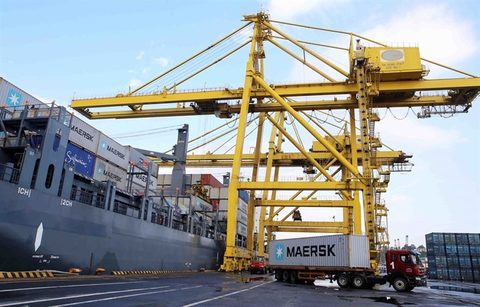World Bank hikes prediction for VN GDP growth
World Bank hikes prediction for VN GDP growth
The World Bank (WB) on Monday released its bi-annual report on Viet Nam’s economy, lifting its forecast for Viet Nam’s 2017 Gross Domestic Product (GDP) growth to 6.7 per cent, from the rate of 6.3 per cent it predicted in July.

The report, titled Taking Stock, said that over the medium term, growth is projected to stabilise at around 6.5 per cent. Inflation is projected to remain low.
Stronger domestic demand, robust export-oriented manufacturing and a gradual recovery of the agricultural sector are driving Viet Nam’s economy, which expanded by 6.4 per cent during the first nine months of the year, the report said.
The manufacturing and services sector respectively grew by 12.8 per cent and 7.3 per cent during the same period, it added.
“Growth momentum picked up across major economies and global trade recovered in 2017,” said Ousmane Dione, the WB Country Director for Viet Nam. “With incomes rising and poverty falling, Viet Nam’s economy had another good year of strong growth and broad macroeconomic stability.”
According to the World Bank’s report, low inflation and rising real wages sustained buoyant domestic demand and private consumption, while the stronger global economy helped Viet Nam’s export-oriented manufacturing and agricultural sectors.
Job growth continued, with 1.6 million new jobs added in the manufacturing sector over the past three years and 700,000 additional jobs in the construction, retail, and hospitality sectors, leading to higher aggregate labour productivity.
Labour demand also contributed to rapid wage growth, with wages increasing by 15 per cent cumulatively between 2014 and 2016.
Despite progress in resolving non-performing loans, financial risks remain. These include the lack of robust capital buffers in some banks, especially amidst rapid credit growth, the report said.
Tighter fiscal policy, lower budget spending
Fiscal tightening is under way, the report highlighted, and has led to a leaner budget deficit and containment of public debt.
However, the decline in public investment – falling to 16 per cent of total spending in the first nine months of 2017 compared with an average of 25 per cent in recent years – may be unsustainable over time, as Viet Nam needs significant investments in infrastructure to support future growth.
A slow-down in structural reforms could also impact the ongoing recovery, especially given the weaker growth in investment. Enhancing macroeconomic resilience and undertaking structural reforms can lift Viet Nam’s growth potential over the medium term.
“Structural reform remains a central priority in light of tepid productivity growth” said Sebastian Eckardt, the World Bank Lead Economist for Viet Nam. “Building on progress already made, Viet Nam can further lift productivity growth through investments in needed infrastructure and skills as well as deeper reforms of the business environment, SOE and banking sector.”
A special section of Taking Stock focused on improving efficiency and equity of public spending. With public debt close to the statutory limit of 65 per cent of GDP, Viet Nam’s government faces tight budget constraints for several years to come.
This special topic section looked at fundamental expenditure reforms in key public services to identify opportunities for constraining expenditure growth through improvements in efficiency.
The report recommended that Viet Nam take advantage of cyclical uptick to strengthen macroeconomic resilience.
In the short run, the country should focus on quality and sustainability of growth, instead of merely the pace of growth. It should also insist on sustainable, growth-friendly fiscal consolidation, responsive monetary and exchange rate policies, addressing non-performing loans, raising capital buffers and managing credit growth.
Regarding structural reforms to boost productivity growth and lift potential growth, Viet Nam needed to strengthen market institutions, deepen and accelerate equitisation, enhance business climate and regulatory reforms, develop capital markets to ensure efficient financial intermediation and alleviate constraints on domestic investment, including in infrastructure and investing in people and innovation capacity.





















